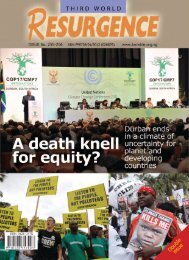Plantations, poverty and power - Critical Information Collective
Plantations, poverty and power - Critical Information Collective
Plantations, poverty and power - Critical Information Collective
You also want an ePaper? Increase the reach of your titles
YUMPU automatically turns print PDFs into web optimized ePapers that Google loves.
95<br />
The ADB’s report notes that the project was delayed “due to prolonged, <strong>and</strong> sometimes breakdown in the<br />
negotiation to secure lease of l<strong>and</strong> owned collectively, <strong>and</strong> reduction of planting areas, both of which led<br />
to postponement of planting activities.” The project was rated as “unsuccessful”. 483<br />
Sri Lanka<br />
A “community forestry project” in Sri Lanka, was rated “generally successful” although less than half the<br />
target of 14,000 hectares was actually planted. The Bank’s 1994 report on forestry lending notes that a<br />
community woodlots component of the project “was termed as a failure <strong>and</strong> so also the five<br />
demonstration woodlots”. 484<br />
Malaysia<br />
Launched in 1982, the “Compensatory Forest Plantation Project” in peninsular Malaysia aimed to cover<br />
188,200 hectares with acacia monocultures by 1995. By the end of 1999, 62,800 hectares had been<br />
planted. Many of the plantations failed because of extensive outbreaks of heartrot disease in the Acacia<br />
mangium plantations. 485<br />
The Philippines<br />
The ADB has supported two plantations projects in the Philippines. Both projects created problems. The<br />
first, approved in 1983, “suffered from deficiencies in Project design <strong>and</strong> implementation,” according to<br />
the Bank’s Project Performance Audit Report. 486 The project was redesigned in 1988, after a typhoon hit<br />
the project area. Instead of planting different tree species, as initially planned, “the Project adopted a<br />
strategy of near monoculture plantations of E. camaldulensis.” The plantations were poorly maintained<br />
<strong>and</strong> “were characterized by highly uneven <strong>and</strong> low tree growth rate.”<br />
The Bank failed to monitor the project adequately. Only one socio-economic survey was carried out <strong>and</strong><br />
only one Bank mission included a visit by a forestry specialist to the project sites. The Project<br />
Performance Audit Report notes that “There was little or no assessment of plantation growth<br />
performance, review of the appropriateness of Project design, <strong>and</strong> determination of the adequacy of<br />
Project staffing input <strong>and</strong> technical competency. No technical advice on forestry establishment or<br />
assistance in the Project performance management system was provided.” 487<br />
A second ADB project in the Philippines, the Industrial Forest Plantation (Sector) Project also ran into<br />
problems. The project started in 1991, <strong>and</strong> aimed to establish 30,000 hectares of industrial tree<br />
483 “Sector synthesis of post-evaluation findings in the forestry sector”, Asian Development Bank, Post-Evaluation<br />
Office, August 1994.<br />
484 “Sector synthesis of post-evaluation findings in the forestry sector”, Asian Development Bank, Post-Evaluation<br />
Office, August 1994.<br />
485 Thai See Kiam (2000) “Forest plantation development in Malaysia <strong>and</strong> the potential of rubber wood as an important<br />
source of timber in the future”, in the Proceedings of the International Conference on Timber Plantation Development, 7-9<br />
November 2000 in Manila, Philippines. http://www.fao.org/docrep/005/ac781e/AC781E09.htm<br />
486 “Project Performance Audit Report on the Forestry Development Project (Loan No. 677-PHI) in the Philippines”,<br />
Asian Development Bank, July 1997.<br />
487 “Project Performance Audit Report on the Forestry Development Project (Loan No. 677-PHI) in the Philippines”,<br />
Asian Development Bank, July 1997.















